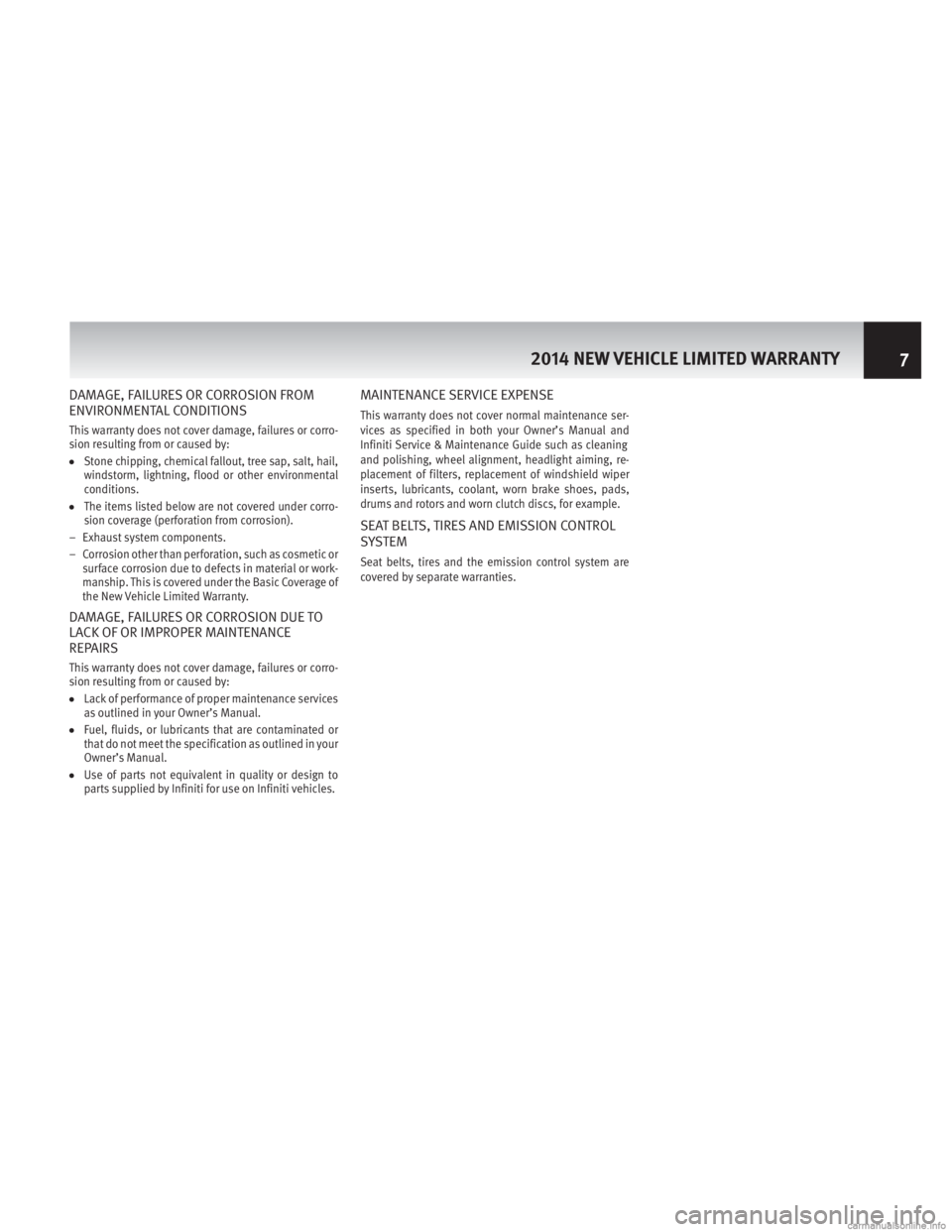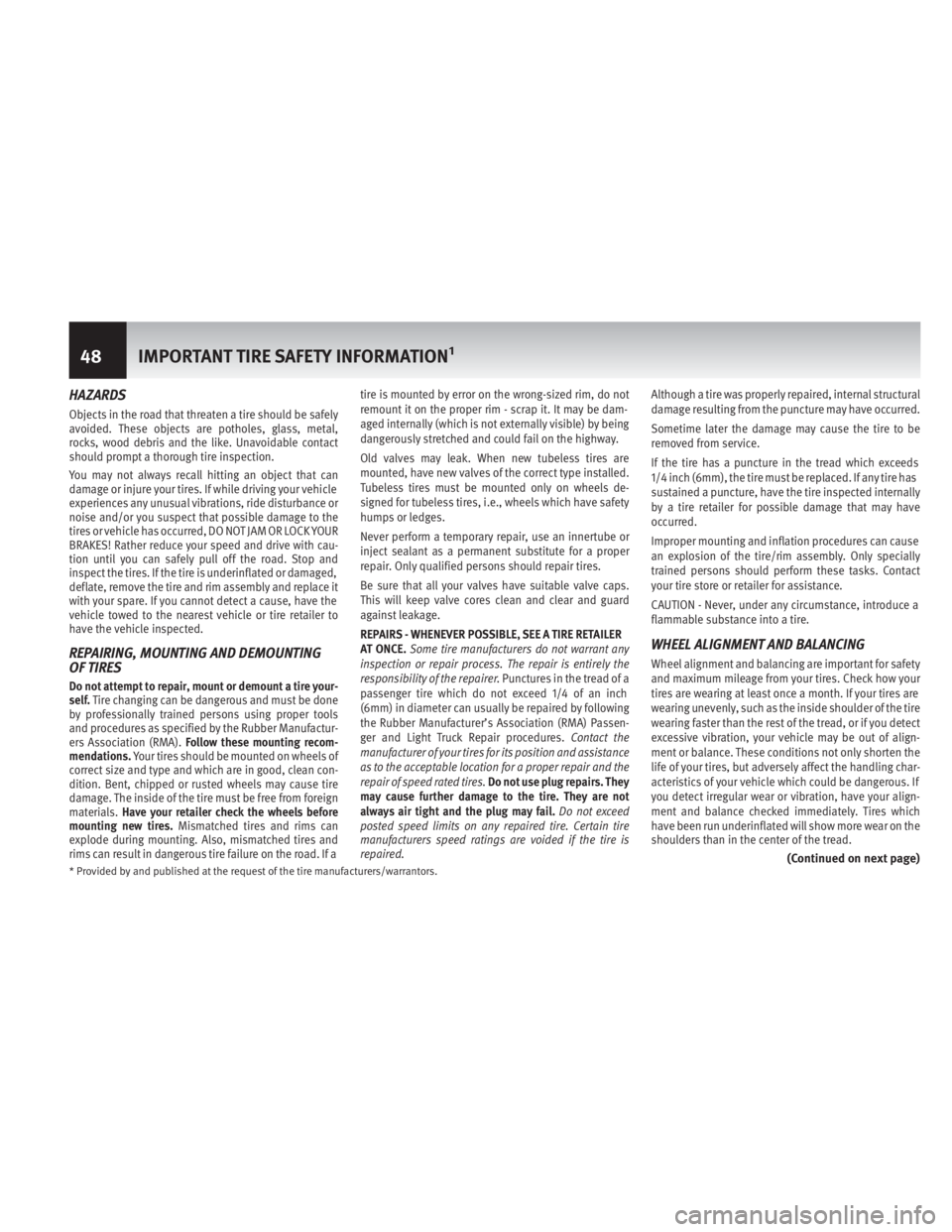brake light INFINITI QX60 2014 Warranty Information Booklet
[x] Cancel search | Manufacturer: INFINITI, Model Year: 2014, Model line: QX60, Model: INFINITI QX60 2014Pages: 58, PDF Size: 0.85 MB
Page 10 of 58

DAMAGE, FAILURES OR CORROSION FROM
ENVIRONMENTAL CONDITIONS
This warranty does not cover damage, failures or corro-
sion resulting from or caused by:
●Stone chipping, chemical fallout, tree sap, salt, hail,
windstorm, lightning, flood or other environmental
conditions.
●The items listed below are not covered under corro-
sion coverage (perforation from corrosion).
– Exhaust system components.
– Corrosion other than perforation, such as cosmetic or
surface corrosion due to defects in material or work-
manship. This is covered underthe Basic Coverage of
the New Vehicle Limited Warranty.
DAMAGE, FAILURES OR CORROSION DUE TO
LACK OF OR IMPROPER MAINTENANCE
REPAIRS
This warranty does not cover damage, failures or corro-
sion resulting from or caused by:
●Lack of performance of proper maintenance services
as outlined in your Owner’s Manual.
●Fuel, fluids, or lubricants that are contaminated or
that do not meet the specification as outlined in your
Owner’s Manual.
●Use of parts not equivalent in quality or design to
parts supplied by Infiniti for use on Infiniti vehicles.
MAINTENANCE SERVICE EXPENSE
This warranty does not cover normal maintenance ser-
vices as specified in both your Owner’s Manual and
Infiniti Service & Maintenance Guide such as cleaning
and polishing, wheel alignment, headlight aiming, re-
placement of filters, replacement of windshield wiper
inserts, lubricants, coolant, worn brake shoes, pads,
drums and rotors and worn clutch discs, for example.
SEAT BELTS, TIRES AND EMISSION CONTROL
SYSTEM
Seat belts, tires and the emission control system are
covered by separate warranties.
2014 NEW VEHICLE LIMITED WARRANTY7
Page 51 of 58

HAZARDS
Objects in the road that threaten a tire should be safely
avoided. These objects arepotholes, glass,metal,
rocks, wood debris and the like. Unavoidable contact
should prompt a thorough tire inspection.
You may not always recall hitting an object that can
damage or injure your tires. If while driving your vehicle
experiences any unusual vibrations, ride disturbance or
noise and/or you suspect that possible damage to the
tires or vehicle has occurred, DO NOT JAM OR LOCK YOUR
BRAKES! Rather reduce your speed and drive with cau-
tion until you can safely pull off the road. Stop and
inspect the tires. If the tire is underinflated or damaged,
deflate, remove the tire and rim assembly and replace it
with your spare. If you cannot detect a cause, have the
vehicle towed to the nearest vehicle or tire retailer to
have the vehicle inspected.
REPAIRING, MOUNTING AND DEMOUNTING
OF TIRES
Do not attempt to repair, mount or demount a tire your-
self.Tire changing can be dangerous and must be done
by professionally trained persons using proper tools
and procedures as specified by the Rubber Manufactur-
ers Association (RMA).Follow these mounting recom-
mendations.Your tires should be mounted on wheels of
correct size and type and which are in good, clean con-
dition. Bent, chipped or rusted wheels may cause tire
damage. The inside of the tire must be free from foreign
materials.Have your retailer check the wheels before
mounting new tires.Mismatched tires and rims can
explode during mounting. Also, mismatched tires and
rims can result in dangerous tire failure on the road. If atire is mounted by error on the wrong-sized rim, do not
remount it on the proper rim - scrap it. It may be dam-
aged internally (which is not externally visible) by being
dangerously stretched and could fail on the highway.
Old valves may leak. When new tubeless tires are
mounted, have new valves of the correct type installed.
Tubeless tires must be mounted only on wheels de-
signed for tubeless tires, i.e., wheels which have safety
humps or ledges.
Never perform a temporary repair, use an innertube or
inject sealant as a permanent substitute for a proper
repair. Only qualified persons should repair tires.
Be sure that all your valves have suitable valve caps.
This will keep valve cores clean and clear and guard
against leakage.
REPAIRS - WHENEVER POSSIBLE, SEE A TIRE RETAILER
AT ONCE.Some tire manufacturers do not warrant any
inspection or repair process. The repair is entirely the
responsibility of the repairer.Punctures in the tread of a
passenger tire which do not exceed 1/4 of an inch
(6mm) in diameter can usually be repaired by following
the Rubber Manufacturer’s Association (RMA)Passen-
ger and Light Truck Repair procedures.Contact the
manufacturer of your tires for its position and assistance
as to the acceptable location for a proper repair and the
repair of speed rated tires.Do not use plug repairs. They
may cause further damage to the tire. They are not
always air tight and the plug may fail.Do not exceed
posted speed limits on any repaired tire. Certain tire
manufacturers speed ratings are voided if the tire is
repaired.Although a tire was properly repaired, internal structural
damage resulting from the puncture may have occurred.
Sometime later the damage may cause the tire to be
removed from service.
If the tire has a puncture in the tread which exceeds
1/4 inch (6mm), the tire must be replaced. If any tire has
sustained a puncture, have the tire inspected internally
by a tire retailer for possible damage that may have
occurred.
Improper mounting and inflation procedures can cause
an explosion of the tire/rim assembly. Only specially
trained persons should perform these tasks. Contact
your tire store or retailer for assistance.
CAUTION - Never, under any circumstance, introduce a
flammable substance into a tire.
WHEEL ALIGNMENT AND BALANCING
Wheel alignment and balancing are important for safety
and maximum mileage from your tires. Check how your
tires are wearing at least once a month. If your tires are
wearing unevenly, such as the inside shoulder of the tire
wearing faster than the rest of the tread, or if you detect
excessive vibration, your vehicle may be out of align-
ment or balance. These conditions not only shorten the
life of your tires, but adversely affect the handling char-
acteristics of your vehicle which could be dangerous. If
you detect irregular wear or vibration, have your align-
ment and balance checked immediately. Tires which
have been run underinflated will show more wear on the
shoulders than in the center of the tread.
(Continued on next page)* Provided by and published at the requestof the tire manufacturers/warrantors.
48IMPORTANT TIRE SAFETY INFORMATION1